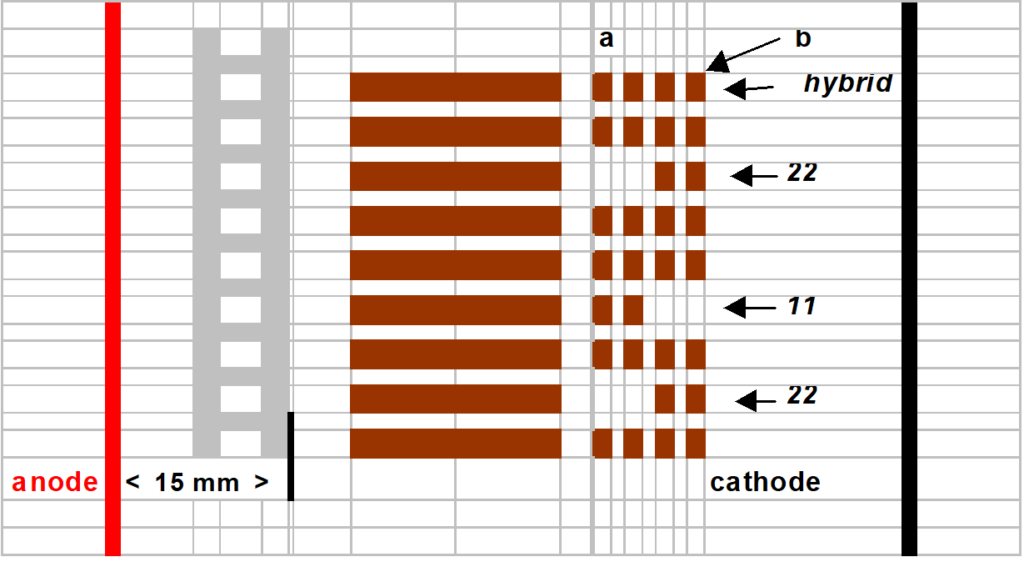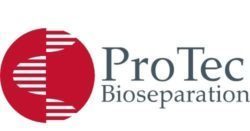
Brassica
ACP – (Acidphospatase)
16 % v/v glycerol
Bring 200 grams (= 160 ml) of glycerol (q.c.w. Sigma G-7757) and 800 ml distilled water in a beaker. Mix well and bring to a final volume of 1000 ml with distilled water. Store in the refrigerator.
Sepalyte pH 3-10 (Cat.No. 42008 ProTec Bioseparation)
Ready to hand Sepalyte solutions. Store in refrigerator
Acrylamide/ bis acrylamide 29 : 1 solution
Ready to hand acrylamide solution (q.c.w. Sigma A-3574). Store in refrigerator.
0.1N Sodium hydroxide
4.0 g sodium hydroxide (q.c.w. Sigma S-8045) in 1000 ml distilled water. Add a trace (tip of a small spatula) of sodium azide (q.c.w. Sigma S-8032). Store at room temperature
0,1% w/v riboflavin
0.05 g riboflavin (q.c.w. Sigma R-0508) in 50 ml 0.1 N sodium hydroxide.
Store in the refrigerator for up to 2 weeks.
10% w/v ammonium persulfate
0.5 g ammonium persulfate (q.c.w. Sigma A- 3678) in 5.0 ml distilled water.
Store in refrigerator for one week
4 N sodium hydroxide
16.0 g sodium hydroxide (q.c.w. Sigma S-8045) in 100 ml distilled water. Store in the refrigerator.
APS extraction solution
2.5 ml PH 3-10 (Cat. No.42008) in 500 ml distilled water. Add a trace (tip of a small spatula) of Orange G (q.c.w. Sigma O-1625).
Store in refrigerator.
0.1M Na-acetate buffer pH 5.0
16.4 g sodium acetate (q.c.w. Sigma S-8750) in 1800 ml distilled water. Stir until fully dissolved. Adjust the pH to 5.0 with acetic acid (q.c.w. BDH27013). Bring to a final volume of 2000 ml with distilled water. Add a trace (tip of a small spatula) of sodium azide (q.c.w. Sigma S-8032).
Store at room temperature.
4 M magnesium chloride
Bring 203g magnesium chloride hexahydrate (q.c.w. Sigma M-0250) and 150 ml distilled water in a beaker. Stir until fully dissolved and bring to a final volume of 250 ml. Store at room temperature.
2 % v/v acetic acid solution
Bring 20 ml of Acetic acid 100%(q.c.w. BDH 27013) in 1000 ml distilled water.
Store at room temperature.
Cathode fluid 10
Bring 0.90 g L-arginine base (Sigma A- 5006)+ 0.70 g L-lysine (Sigma L-5501)+ 24.0 ml ethylene diamine (q.c.w. Sigma E-9890) in 200 ml water.
Store in refrigerator.
Anode fluid 3
Bring 0.68 g L-glutamic acid (q.c.w. Sigma G-6904) and 0.72 L-aspartic acid (q.c.w. Sigma A-8949) in 200 ml distilled water. Stir until fully dissolved.
Store in refrigerator.
TEMED
Ready to use TEMED Sigma ( T-9281).
Gel preparation
9.5 ml 16 % glycerol
2.0 ml Acrylamide/bis 29:1solution
1.0 ml Sepalyte pH 3-10
0.065 ml 0.1 % w/v riboflavin
0.012 ml TEMED
0.035 ml 10% ammonium persulfate
Add the above reagents and swirl to mix. Pour the gel according to the flap technique and allow polymerizing for at least 4 hours under light. Store the gels in a sealed bag in the refrigerator for up to 2 weeks.
Sample preparation
Single seeds are placed into a 96 well microplate. To each well an aliquot of cold APS extraction solution is added. The aliquot to be added depends on the fraction size of the seed.
fraction size 1.25 – 1.49 mm + 100 ml ACP extraction solution
fraction size 1.50 – 1.74 mm + 125 ml ACP extraction solution
fraction size 1.75 – 1.99 mm + 150 ml ACP extraction solution
fraction size 2.00 – 2.24 mm + 175 ml ACP extraction solution
fraction size 2.25 – 2.50 mm + 200 ml ACP extraction solution
The seeds are homogenized using the Terminator for 3 minutes and centrifuged for 10 minutes at 3000 rpm. at 10° C (or at room temperature).
Electrophoresis
Turn the cooling supply on and set at a temperature of ± 15° C. Remove the gel from the glass plates. Clean the back of the gel with methanol/ethanol. Place the gel onto the cooling plate with several ml of water. The gel can be divided into two or three parts. Space the electrodes evenly across the gel, alternating cathode (black electrode) and anode (red electrode). Place the electrode plateau directly onto the gel, making electrode imprints in the gel. Blotting paper wicks (1 x 6-x 260 mm) are used. Wet the cathode wicks with cathode fluid 10 and the anode wicks with anode fluid 3. Gently blot the wicks but keep them fairly wet. Place the cathode wicks onto the cathode imprints in the gel and the anode wicks onto the anode imprint. Bring the electrode plateau on top of the electrode wicks. Power settings are for one gel (double the mA and Watts when running two gels).
Prefocusing
Run 1: 600 V–60 mA–12 W–50 V/h
Sample application
After the prefocusing step, the 96 templates are positioned ± 15 mm from the anode (red electrode). See cartoon image section “gel interpretation 9.1.6.“
Each sample well is filled with 8 µl of supernatant.
Focusing
Run 2: 200 V–60 mA–12 W–50 V/h
Run 3: 1000 V–60 mA–12 W–1000 V/h
After the gel has finished running, remove the gel from the cooling plate and place into an appropriate staining tray.
ACP staining
200 ml 0.1 M sodium acetate pH 5.0
0.300 ml 4 M MgCl2
0.25 g a-naphthyl acid phosphate (Sigma N-7255)
0.25 g Fast Garnet (Sigma F-8761)
Gel interpretation
No international enzyme classification is used.
The nearest band of interest from the anode is genotyped “11”.
The farthest band of interest from the anode is genotyped “ 22”.
The hybrid is genotyped “1/2” in case that the female is 11 and the male 22.
The hybrid is genotyped “2/1” in case that the female is 22 and the male 11.

ProTec Bioseparation (Protein Electrophoresis)
